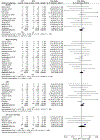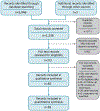Short-Term Antiplatelet Versus Anticoagulant Therapy After Left Atrial Appendage Occlusion: A Systematic Review and Meta-Analysis
- PMID: 32439033
- PMCID: PMC7988890
- DOI: 10.1016/j.jacep.2019.11.009
Short-Term Antiplatelet Versus Anticoagulant Therapy After Left Atrial Appendage Occlusion: A Systematic Review and Meta-Analysis
Abstract
Objectives: The aim of this study was to compare bleeding, thromboembolic, device-related thrombus (DRT), and all-cause mortality events between patients treated with short-term oral anticoagulation (OAC) and those treated with short-term antiplatelet therapy (APT) following left atrial appendage occlusion (LAAO).
Background: Short-term OAC is recommended for patients following LAAO. However, in practice many patients receive APT rather than OAC because of excessive bleeding risk. However, the safety and efficacy of APT compared with OAC have been debated.
Methods: A search was conducted of databases for studies comparing OAC with APT following LAAO. The outcomes of interest were all-cause stroke, major bleeding, DRT, and all-cause mortality. Noncomparative studies were pooled into a single study to generate comparisons of the studies' outcomes. Effects measure were pooled using the random-effect model.
Results: A total of 83 studies with 12,326 patients (APT, n = 7,900; OAC, n = 4,151) were included. Mean CHA2DS2-VASc and HAS-BLED scores were 4.1 ± 1.6 and 3.0 ± 1.3, respectively. There were no significance differences between the APT and OAC groups with regard to stroke (risk ratio [RR]: 1.04; 95% confidence interval [CI]: 0.54 to 1.98; p = 0.91; I2 = 31%), major bleeding (RR: 1.12; 95% CI: 0.68 to 1.84; p = 0.65; I2 = 53%), DRT (RR: 1.33; 95% CI: 0.74 to 2.39; p = 0.33; I2 = 36%), and all-cause mortality (RR: 1.29; 95% CI: 0.40 to 4.09; p = 0.18; I2 = 36%). These findings persisted in multiple secondary analyses: 1) excluding studies that reported no events; 2) including comparative studies only; 3) excluding patients who were treated with single APT; and 4) removing one study at a time to assess the effect of each study on the overall effect size. There was also no difference in the studies' endpoints among patients who received different LAAO devices.
Conclusions: In a meta-analysis of observational data, there were no differences in the occurrence of stroke, major bleeding DRT, and all-cause mortality in patients treated with short-term OAC or APT following LAAO.
Keywords: antiplatelet therapy; atrial fibrillation; left atrial appendage occlusion; oral anticoagulation; stroke.
Copyright © 2020 American College of Cardiology Foundation. Published by Elsevier Inc. All rights reserved.
Figures





References
-
- Alkhouli M, Noseworthy PA, Rihal CS, Holmes DR Jr. Stroke prevention in nonvalvular atrial fibrillation: a stakeholder perspective. J Am Coll Cardiol 2018;71:2790–801. - PubMed
-
- Holmes DR Jr., Alkhouli M, Reddy V. Left atrial appendage occlusion for the unmet clinical needs of stroke prevention in nonvalvular atrial fibrillation. Mayo Clin Proc 2019;94:864–74. - PubMed
-
- Reddy VY, Doshi SK, Kar S, et al. 5-Year outcomes after left atrial appendage closure: from the PREVAIL and PROTECT AF trials. J Am Coll Cardiol 2017;70:2964–75. - PubMed
-
- Søndergaard L, Wong Y-H, Reddy VY, et al. Propensity-matched comparison of oral anticoagulation versus antiplatelet therapy after left atrial appendage closure with Watchman. J Am Coll Cardiol Intv 2019;12:1055–63. - PubMed
-
- Saw J Is antiplatelet therapy after Watchman implantation adequate? J Am Coll Cardiol Intv 2019;12:1064–6. - PubMed
Publication types
MeSH terms
Substances
Grants and funding
LinkOut - more resources
Full Text Sources
Medical
Miscellaneous

